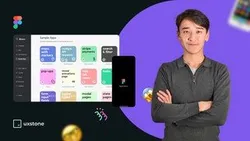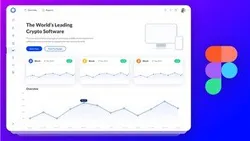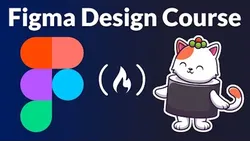
Create a High-Fidelity Prototype with Figma 
In this 1 hour guided project, participants will learn the fundamentals of high-fidelity prototyping and how to use Figma to create a prototype for a pizza restaurant mobile application. They will gain an understanding of how high-fidelity prototypes closely resemble the final product and how to share their work with team members and clients to refine the design. Basic mobile application user interface knowledge is recommended. ▼
ADVERTISEMENT
Course Feature
![]() Cost:
Cost:
Paid
![]() Provider:
Provider:
Coursera
![]() Certificate:
Certificate:
Paid Certification
![]() Language:
Language:
English
![]() Start Date:
Start Date:
22nd May, 2023
Course Overview
❗The content presented here is sourced directly from Coursera platform. For comprehensive course details, including enrollment information, simply click on the 'Go to class' link on our website.
Updated in [March 06th, 2023]
(Please note the following content is from the official provider.)
In this 1 hour guided project, you will first learn the fundamental principles of high-fidelity prototyping. Then you will learn the basic techniques of using Figma to create a high-fidelity prototype for a pizza restaurant mobile application. High-fidelity prototypes closely resemble the final product and give users and developers a real taste of how the features work. Finally you will learn how to share your work with team members and clients to refine your design with them. Prior knowledge with basic mobile application user interface is recommended.
An account with Figma is required for this project. If you do not already have an account. You can create a free account with Figma. To make your learning experience smoother, please do so prior to starting the project.
(Please note that we obtained the following content based on information that users may want to know, such as skills, applicable scenarios, future development, etc., combined with AI tools, and have been manually reviewed)
Are you ready to create a high-fidelity prototype with Figma? In this course, you will learn the fundamental principles of high-fidelity prototyping and the basic techniques of using Figma to create a high-fidelity prototype for a pizza restaurant mobile application. You will also learn how to share your work with team members and clients to refine your design with them.
Course Overview: This course will provide you with the knowledge and skills to create a high-fidelity prototype with Figma. You will learn the fundamental principles of high-fidelity prototyping and the basic techniques of using Figma to create a high-fidelity prototype for a pizza restaurant mobile application. You will also learn how to share your work with team members and clients to refine your design with them.
Possible Development Directions: After completing this course, you will be able to create a high-fidelity prototype with Figma. You can use this knowledge to create prototypes for other mobile applications or websites. You can also use this knowledge to create prototypes for other types of projects, such as games or virtual reality applications.
Related Learning Suggestions: To make the most of this course, it is recommended that you have prior knowledge with basic mobile application user interface. You should also create a free account with Figma prior to starting the project. After completing this course, you can explore other courses related to Figma, such as creating a low-fidelity prototype with Figma or creating a user interface with Figma.
[Applications]
Upon completion of this course, participants should be able to create a high-fidelity prototype with Figma. They should be able to use the basic techniques of Figma to create a prototype for a mobile application. Participants should also be able to share their work with team members and clients to refine their design. Additionally, participants should be familiar with the fundamental principles of high-fidelity prototyping.
[Career Paths]
1. UX/UI Designer: UX/UI Designers are responsible for creating user-friendly and visually appealing interfaces for websites and mobile applications. They use tools such as Figma to create high-fidelity prototypes that closely resemble the final product. This job is becoming increasingly important as more businesses move their operations online and require user-friendly interfaces.
2. Product Designer: Product Designers are responsible for creating the overall look and feel of a product. They use tools such as Figma to create high-fidelity prototypes that closely resemble the final product. This job is becoming increasingly important as businesses strive to create products that are both visually appealing and user-friendly.
3. Interaction Designer: Interaction Designers are responsible for creating user experiences that are both intuitive and engaging. They use tools such as Figma to create high-fidelity prototypes that closely resemble the final product. This job is becoming increasingly important as businesses strive to create products that are both visually appealing and user-friendly.
4. Visual Designer: Visual Designers are responsible for creating visually appealing designs for websites and mobile applications. They use tools such as Figma to create high-fidelity prototypes that closely resemble the final product. This job is becoming increasingly important as businesses strive to create products that are both visually appealing and user-friendly.
Pros & Cons

Easy to use

Highfidelity results

Limited features compared to other tools
Course Provider

Provider Coursera's Stats at AZClass
Discussion and Reviews
0.0 (Based on 0 reviews)
Explore Similar Online Courses

How to start a social media management agency

Grounding Techniques for Anxiety

Python for Informatics: Exploring Information

Social Network Analysis

Introduction to Systematic Review and Meta-Analysis

The Analytics Edge

DCO042 - Python For Informatics

Causal Diagrams: Draw Your Assumptions Before Your Conclusions

Whole genome sequencing of bacterial genomes - tools and applications

From idea to MVP without coding Intro to Figma & Bravo

Learn How to Design a Website in Figma


Start your review of Create a High-Fidelity Prototype with Figma